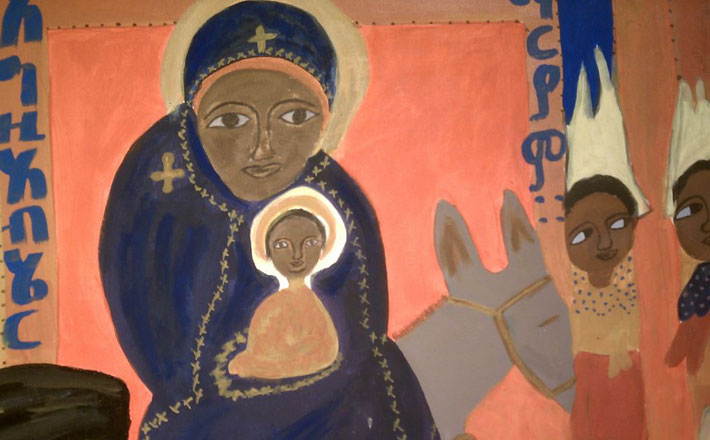Commentary on Isaiah 9:2-7
Children, especially new children, are often a cause for joy.
This was certainly the case for the author of Isaiah 9:1-7 [Hebrew 8:23-9:6]: “For a child has been born to us, a son given to us” (v. 6, NRSV). But before the joy of birth was the darkness of judgment. Formerly, Yhwh had afflicted the lands of Zebulun and Naphtali, but in the latter time, he will make glorious “way of the sea,” the land beyond the Jordan, and “Galilee of the nations” (v. 1 NRSV). These cryptic descriptions refer to 8th century Assyrian imperial incursions into Israel, which ultimately resulted in the fall of the Northern Kingdom in 721 BCE. The nature of the Hebrew verbs in this oracle, however, do not allow us to determine if the oracle given is about the future or past. Be that as it may, this text either anticipates or reflects upon a significant moment in Israel’s history, when it stood between judgment and salvation, oppression and freedom, darkness and light. And at the center of it all is a child. But what child is this?
In order to answer this question, we need to know a little more about this remarkable oracle that describes the in-breaking of light into dark places and of dawn into the heart of a long and shadowy night (Isaiah 9:1). Whatever this new work of salvation is, it will result in the magnification of the nation, waves of joy, and the kind of celebration that come from success at harvest time and victory on the battlefield (v. 2).
Isaiah 9:4-6 give three reasons for this influx of joy: First, the “yoke of their burden, and the bar across their shoulders, the rod of their oppressor” has been broken “as on the day of Midian.” The image of an animal wearing a yoke utilizes a common metaphor for the subjugation of one nation by another, often with the requirement of tribute (see Jeremiah 27). To pull the yoke for another king is to serve as his vassal. The rod in this case refers generally to authority and power, even military power, and often occurs in First Isaiah with reference to Assyria (Isaiah 10:5, 15, 24). Liberation from empire — the Assyrian empire in particular — is what is at stake in this oracle. Although we often feel uncomfortable mixing “faith and politics” in the pulpit, this distinction was entirely unknown to Israel’s prophets.
Second, the oracle makes the bold declaration that war will come to an end — at least this war will — and a new age of peace will ensue. In celebration of this new era, the old garments of war — boots for trampling and clothing stained with blood — are incinerated (Isaiah 9:5).
Finally, and climactically, joy erupts because a “child has been born for us, a son given to us.” But this is no ordinary child. “Authority” or “dominion” will be upon his shoulders, and he has a series of exalted titles: “A mighty God who plans wonders” (my translation), “everlasting father,” (NRSV), “peaceable ruler” (TNK). It is not at all unusual for a person’s name to be a sentence: Elijah (Yahweh is my God), Isaiah (Yhwh saves), etc. These titles are best understood as elements of the royal titulary. It is important to note that, within the larger cultural context, these titles do not actually describe the ruler himself (i.e., the child) but rather the deity who has placed the ruler on the throne. This interpretation of course stands in significant tension with traditional Christian interpretation, which has attributed such titles to Jesus.
So what child is this? The “child” described in Isaiah 9 is likely Hezekiah son of Ahaz (727 BCE-698 BCE), one of the very few royal heroes of Kings, who receives rare praise from the book’s deuteronomistic editors: “He [Hezekiah] did what was right in the sight of the Lord just as his ancestor David had done” (2 Kings 18:3). Hezekiah’s reign is described in 2 Kings 18-20. He receives even higher praise in the Chronicler’s parallel version (see 2 Chronicles 29-32), where he is depicted as both a new David and a new Solomon.1
Significantly, Hezekiah’s reign also plays an important role near the end of First Isaiah (Isaiah 1-39). Contrary to his father Ahaz who trusted in foreign assistance from the Assyrians rather than Yhwh (see Isaiah 7:10-17), Hezekiah is the paragon of faith and faithfulness. When Sennacherib’s armies threatened Jerusalem, Hezekiah trusted in Yhwh’s faithfulness and his power to save the city from Assyrian aggression (Isaiah 37). Hezekiah’s greatness, then, is not in his ability to bear the load of authority or to create an era of “peace” with his own hands. Rather, his greatness lies in his willingness to trust in God who can bring about these things, on earth as it is in heaven, and even we might add in a place as contentious as Jerusalem.
Notes:
1 See Mark A. Throntveit, “The Relationship of Hezekiah to David and Solomon in the Books of Chronicles,” in The Chronicler as Theologian: Essays in Honor of Ralph W. Klein (ed. M. Patrick Graham, Steven L. McKenzie, and Gary N. Knoppers; JSOTSup 371; London: T&T Clark, 2003), 105-121.


December 24, 2014